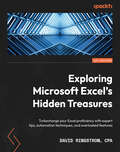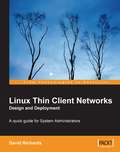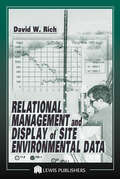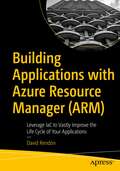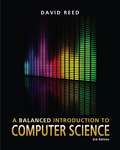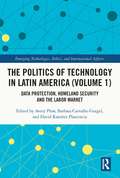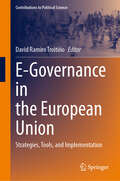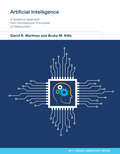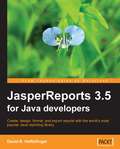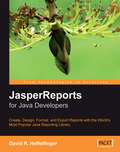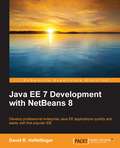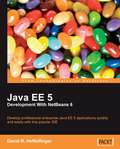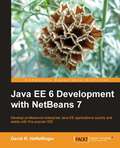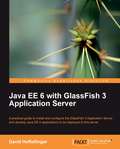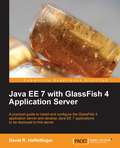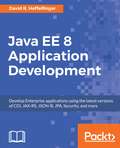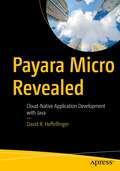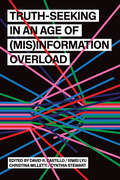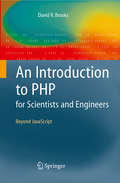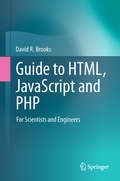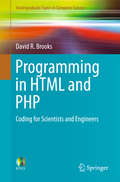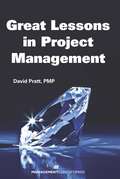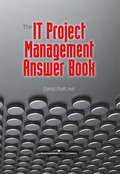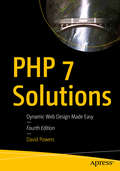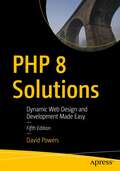- Table View
- List View
Exploring Microsoft Excel's Hidden Treasures: Turbocharge your Excel proficiency with expert tips, automation techniques, and overlooked features
by David RingstromDiscover timesaving features, accessibility and internal control approaches, data integrity improvements, and spreadsheet automation techniques by exploring Excel shortcuts and nuances in Microsoft 365, Excel versions till 2021Key FeaturesGet hands-on experience by carrying out techniques in detailed example workbooksReclaim portions of your day by immediately implementing data integrity and automation featuresIncorporate spreadsheet disaster recovery techniques into your daily workBook DescriptionDavid Ringstrom coined the phrase “Either you work Excel, or it works you!” after observing how many users carry out tasks inefficiently.In this book, you'll learn how to get more done with less effort. This book will enable you to create resilient spreadsheets that are easy for others to use as well, while incorporating spreadsheet disaster preparedness techniques. The time-saving techniques covered in the book include creating custom shortcuts and icons to streamline repetitive tasks, as well as automating them with features such as Tables and Custom Views. You'll see how Conditional Formatting enables you to apply colors, Cell icons, and other formatting on-demand as your data changes. You'll be empowered to protect the integrity of spreadsheets and increase usability by implementing internal controls, and understand how to solve problems with What-If Analysis features. In addition, you'll master new features and functions such as XLOOKUP, Dynamic Array functions, LET and LAMBDA, and Power Query, while learning how to leverage shortcuts and nuances in Excel.By the end of this book, you'll have a broader awareness of how to avoid pitfalls in Excel. You'll be empowered to work more effectively in Excel, having gained a deeper understanding of the frustrating oddities that can arise daily in Excel.What you will learnExplore hidden and overlooked features that will save your timeImplement disaster prevention and recovery techniquesImprove spreadsheet accessibility for all usersBolster data integrity and spreadsheet resilienceCraft code-free custom worksheet functions with LAMBDACreate code-free report automation with Power QueryIntegrate spreadsheet automation techniques with easeWho this book is forThis book is for intermediate to advanced excel users working in diverse roles such as business users, accountants, project managers and business analysts among others. The more time that you spend in excel the more time this book will save you. You will be able to maximize your productivity by learning spreadsheet interactivity, accessibility and automation. This clear step-by-step explanation and detailed example workbook will help you to try out new techniques firsthand and leverage them for your business's advantage in no time.
Linux Thin Client Networks Design and Deployment
by David RichardsThe book consists of HOW-TOs for all elements of setting up a thin client network, as well as expert advice on decision making, based on the authors experience creating a thin client network for the city of Largo, Florida. The book is for System Administrators interested in designing and setting up a Linux thin client network and provides enough knowledge to understand how the technology works, make decisions about deployment, and then implement a stable work environment.
Relational Management and Display of Site Environmental Data
by David RichWhen your environmental project reaches the point where the amount of data seems overwhelming, you will need a robust tool to help you manage it. Written by a recognized expert and software author with over 25 years of industry experience, Relational Management and Display of Site Environmental Data begins with an overview of site data management c
Building Applications with Azure Resource Manager (ARM): Leverage IaC to Vastly Improve the Life Cycle of Your Applications
by David RendónLearn how to leverage infrastructure as code with Azure Resource Manager (ARM) and the best practices to build, test, debug, and deploy your applications in Microsoft Azure using ARM templates and the new domain-specific language Bicep.As organizations consider moving partially or fully to the cloud, infrastructure as code (IaC) has become a key component to improving time to market for their applications. However, it is critical that enterprise infrastructure professionals use the right resources and strategies to build the infrastructure required to run applications in the cloud. Azure cloud-native components and capabilities automate the build and deployment process, offering a myriad of compelling reasons to leverage IaC to build your applications in Azure.Starting with the evolution of the software-defined approach and building on the basic concepts of infrastructure as code, this book provides you with comprehensive guidance to learn Azure Resource Manager from the ground up. You will learn the best practices for deploying and maintaining application infrastructure, such as template authoring tooling enhancements, Azure DevOps integrations, and updates to the deployment platform.After reading this book, you will understand the breadth and use cases of ARM capabilities and tooling within Microsoft Azure. You will be able to build, test, debug, and deploy your ARM templates and know how to use infrastructure as code to better manage the life cycle of your applications in Azure.What You Will LearnIntroduces the concepts of infrastructure as code and how to leverage it using Azure Resource ManagerTeaches how to enable and deploy Azure Resource Manager templatesCovers the basic core elements of an ARM template to start authoring your templates and building your applications in the cloudDives into core components such as parameters, variables, functions, dependencies, deployment modes, loops, conditions), enabling nested templates Reveals the built-in services and features in Azure, allowing the debugging process and validation process of the ARM templatesDiscusses “Bicep” the language for ARM templates and the DevOps integration to deploy ARM templatesWho This Book Is ForPeople who build, install, repair, or maintain the hardware and software associated with computer systems on-premises and who want to learn about the deployment and provisioning process of applications in the Microsoft Cloud using an infrastructure as code approach through Azure Resource Manager. Readers should have an Azure account and be familiar with the main Azure services (storage, compute, networking, management). Basic knowledge of PowerShell is also useful.
A Balanced Introduction to Computer Science
by David ReedA Balanced Introduction to Computer Science, 3/e is ideal for Introduction to Computing and the Web courses in departments of Math and Computer Science. <p><p> This thoughtfully written text uses the Internet as a central theme, studying its history, technology, and current use. Experimental problems use Web-based tools, enabling students to learn programming fundamentals by developing their own interactive Web pages with HTML and JavaScript. Integrating breadth-based and depth-based chapters, Reed covers a broad range of topics balanced with programming depth in a hands-on, tutorial style.
The Politics of Technology in Latin America: Data Protection, Homeland Security and the Labor Market (Emerging Technologies, Ethics and International Affairs)
by Avery Plaw David Ramírez Plascencia Barbara Carvalho GurgelThis book analyses the arrival of emerging and traditional information and technology for public and economic use in Latin America. It focuses on the governmental, economic and security issues and the study of the complex relationship between citizens and government. The book is divided into three parts: • ‘Digital data and privacy, prospects and barriers’ centers on the debates among the right of privacy and the loss of intimacy in the Internet, • ‘Homeland security and human rights’ focuses on how novel technologies such as drones and autonomous weapons systems reconfigure the strategies of police authorities and organized crime, • ‘Labor Markets, digital media and emerging technologies’ emphasize the legal, economic and social perils and challenges caused by the increased presence of social media, blockchain-based applications, artificial intelligence and automation technologies in the Latin American economy. This first volume in a two volume set will be important reading for scholars and students of governance in Latin American, the protection of human rights and the use of technology to combat crime and the new advances of digital economy in the region.
E-Governance in the European Union: Strategies, Tools, and Implementation (Contributions to Political Science)
by David Ramiro TroitiñoThis book sheds new light on the future of e-governance in the European Union (EU). Drawing on the first-hand professional experience of practitioners, policymakers, and institutional stakeholders, combined with a sound academic foundation, it offers insights into successful implementation strategies and new tools necessary for efficient e-governance in the European Union. The authors present key topics, e.g. the development of e-services such as e-identity, e-health, e-democracy, as well as e-governance tools for the correct implementation of the Digital Single Market. Furthermore, they discuss the legal framework needed for the implementation of these services, such as data protection, digital competition law, as well as EU contracts in digital environments. Finally, the authors highlight efforts to include ethical standards and European values in the decision-making, while developing a vision for the future use of e-governance in the European Union.Understanding the tools and strategies for a successful implementation of e-governance services, as well as the necessary legal framework, will allow professionals such as policymakers and institutional stakeholders, to improve their performance and achieve better results when working on the development of future e-governance services in the European Union.
Artificial Intelligence: A Systems Approach from Architecture Principles to Deployment (MIT Lincoln Laboratory Series)
by David R. Martinez Bruke M. KifleThe first text to take a systems engineering approach to artificial intelligence (AI), from architecture principles to the development and deployment of AI capabilities.Most books on artificial intelligence (AI) focus on a single functional building block, such as machine learning or human-machine teaming. Artificial Intelligence takes a more holistic approach, addressing AI from the view of systems engineering. The book centers on the people-process-technology triad that is critical to successful development of AI products and services. Development starts with an AI design, based on the AI system architecture, and culminates with successful deployment of the AI capabilities. Directed toward AI developers and operational users, this accessibly written volume of the MIT Lincoln Laboratory Series can also serve as a text for undergraduate seniors and graduate-level students and as a reference book. Key features:In-depth look at modern computing technologies Systems engineering description and means to successfully undertake an AI product or service development through deploymentExisting methods for applying machine learning operations (MLOps)AI system architecture including a description of each of the AI pipeline building blocksChallenges and approaches to attend to responsible AI in practice Tools to develop a strategic roadmap and techniques to foster an innovative team environment Multiple use cases that stem from the authors&’ MIT classes, as well as from AI practitioners, AI project managers, early-career AI team leaders, technical executives, and entrepreneurs Exercises and Jupyter notebook examples
JasperReports 3.5 for Java Developers
by David R. HeffelfingerThis book is a comprehensive and practical guide aimed at getting the results you want as quickly as possible. The chapters gradually build up your skills and by the end of the book you will be confident enough to design powerful reports. Each concept is clearly illustrated with diagrams and screen shots and easy-to-understand code. If you are a Java developer who wants to create rich reports for either the Web or print, and wants to get started quickly with JasperReports to do this, this book is for you. No knowledge of JasperReports is presumed.
JasperReports for Java Developers
by David R. HeffelfingerThis book is a concise and practical guide aimed at getting the results you want as quickly as possible. This book is for Java developers who want to create rich reports for either the web or print, and want to get started quickly with JasperReports to do this. No knowledge of JasperReports is presumed, although obviously familiarity with Java, SQL, and XML are assumed where they are required.
Java EE 5 Development with NetBeans 6
by David R. HeffelfingerThis book takes you through the important parts of Java EE development and, with clear, careful instructions and screenshots, shows you the relevant features of the NetBeans IDE. The book is aimed at Java developers who wish to develop Java EE applications while taking advantage of NetBeans functionality to automate repetitive tasks and to ease their software development efforts. Familiarity with Java EE is not assumed.
Java EE 5 Development with NetBeans 6
by David R. HeffelfingerThis book takes you through the important parts of Java EE development and, with clear, careful instructions and screenshots, shows you the relevant features of the NetBeans IDE. The book is aimed at Java developers who wish to develop Java EE applications while taking advantage of NetBeans functionality to automate repetitive tasks and to ease their software development efforts. Familiarity with Java EE is not assumed.
Java EE 6 Development with NetBeans 7
by David R. HeffelfingerThe book is a practical guide explaining the various features of the NetBeans IDE related to enterprise application development. The book is aimed at Java developers who wish to develop Java EE applications while taking advantage of NetBeans functionality to automate repetitive tasks and to ease their software development efforts. Familiarity with NetBeans or Java EE is not assumed.
Java EE 6 with GlassFish 3 Application Server
by David R. HeffelfingerThis book is a practical guide with a very user-friendly approach. It aims to speed up the reader in Java EE 6 development. All major Java EE 6 APIs and the details of the GlassFish 3 server are covered followed by examples of its use. If you are a Java developer and wish to become proficient with Java EE 6, then this book is for you. You are expected to have some experience with Java and to have developed and deployed applications in the past, but need no previous knowledge of Java EE or J2EE. You will also learn how to use GlassFish 3 to develop and deploy applications.
Java EE 7 with GlassFish 4 Application Server
by David R. HeffelfingerThis book is a practical guide and follows a very user-friendly approach. The book aims to get the reader up to speed in Java EE 7 development. All major Java EE 7 APIs and the details of the GlassFish 4 server are covered followed by examples of their use. If you are a Java developers who wants to become proficient with Java EE 7 this book is ideal for you. Readers are expected to have some experience with Java and to have developed and deployed applications in the past, but don’t need any previous knowledge of Java EE or J2EE. It teaches the reader how to use GlassFish 4 to develop and deploy applications.
Java EE 8 Application Development
by David R. HeffelfingerDevelop Enterprise Java applications compliant with the latest version of the Java EE specification About This Book • This book covers all of the major Java EE 8 APIs and includes new additions such as enhanced Security, JSON-B Processing, and more • Learn additional Java EE APIs, such as the Java API for Websocket and the Java Message Service (JMS) • Develop applications by taking advantage of the latest versions of CDI, Security, Servlets, and JSF and other Java EE specifications Who This Book Is For If you are a Java developer who wants to become proficient with Java EE 8, this book is ideal for you. You are expected to have some experience with Java and to have developed and deployed applications in the past, but you don't need any previous knowledge of Java EE. What You Will Learn • Develop and deploy Java EE applications • Embrace the latest additions to the Contexts and Dependency Injection (CDI) specification to develop Java EE applications • Develop web-based applications by utilizing the latest version of JavaServer Faces, JSF 2.3. • Understand the steps needed to process JSON data with JSON-P and the new JSON-B Java EE API • Implement RESTful web services using the new JAX-RS 2.1 API, which also includes support for Server-Sent Events (SSE) and the new reactive client API In Detail Java EE is an Enterprise Java standard. Applications written to comply with the Java EE specification do not tie developers to a specific vendor; instead they can be deployed to any Java EE compliant application server. With this book, you'll get all the tools and techniques you need to build robust and scalable applications in Java EE 8. This book covers all the major Java EE 8 APIs including JSF 2.3, Enterprise JavaBeans (EJB) 3.2, Contexts and Dependency Injection (CDI) 2.0, the Java API for WebSockets, JAX-RS 2.1, Servlet 4.0, and more. The book begins by introducing you to Java EE 8 application development and goes on to cover all the major Java EE 8 APIs. It goes beyond the basics to develop Java EE applications that can be deployed to any Java EE 8 compliant application server. It also introduces advanced topics such as JSON-P and JSON-B, the Java APIs for JSON processing, and the Java API for JSON binding. These topics dive deep, explaining how the two APIs (the Model API and the Streaming API) are used to process JSON data. Moving on, we cover additional Java EE APIs, such as the Java API for Websocket and the Java Message Service (JMS), which allows loosely coupled, asynchronous communication. Further on, you'll discover ways to secure Java EE applications by taking advantage of the new Java EE Security API. Finally, you'll learn more about the RESTful web service development using the latest JAX-RS 2.1 specification. You'll also get to know techniques to develop cloud-ready microservices in Java EE. Style and approach The book takes a pragmatic approach, showing you various techniques to utilize new features of Java EE 8 specification. It is packed with clear, step-by-step instructions, practical examples, and straightforward explanations.
Payara Micro Revealed: Cloud-Native Application Development with Java
by David R. HeffelfingerDevelop, configure, and deploy Java cloud-native applications using Payara Micro. This book demystifies Java cloud-native application development using standard Microprofile APIs and covers Payara-specific features such as automatic clustering and application initialization performance improvements. You will learn how to improve startup performance by taking advantage of class data sharing, and configure cloud-native applications via standard development tools such as Maven and Gradle. The book also clarifies how to develop functionality necessary in a cloud environment, such as health checks and request tracing, using MicroProfile APIs. The book begins by showing how to develop microservices using RESTful web services, followed by how to create microservice clients using MicroProfile and the REST client API. Dependency Injection via Jakarta Context and Dependency Injection (CDI) is also covered. Various approaches to application configuration are covered as well, including property files, environment variables, and system properties. You will learn to configure fault tolerance and high availability, generate system and custom application metrics, and generate health checks to automatically improve overall application health. You will know how to trace the flow of a request across service boundaries with OpenTracing. You will be able to make future maintenance easily through generating documentation, including how to automatically update documentation as your code is updated. Additionally, you will learn how to secure cloud applications and to automatically cluster applications and improve application startup performance.What You Will LearnDevelop microservices using standard Java APIsImplement cloud functionality such as request tracing and health checksDeploy applications as thin archives and as uber archivesConfigure applications via Maven and GradleGenerate custom metrics for capacity planning and proactive discovery of issuesImplement features in support of high availability and fault toleranceSecure your applications with Jason Web TokensTake advantage of Payara’s own cloud platform for easy deploymentWho This Book Is ForJava developers who wish to develop cloud-native applications and microservices, and Java EE application developers who wish to transition to developing cloud-native applications that are lightweight and easily deployed
Truth-Seeking in an Age of (SUNY series, Humanities to the Rescue)
by David R. Castillo, Siwei Lyu, Christina Milletti, and Cynthia StewartThe unprecedented spread of false and misleading information is the flip side of the Internet's promise of universal access and information democratization. This volume features original contributions from scholars working on the challenge of misinformation across a wide range of STEM, humanities, and art disciplines. Modeling a collaborative, multidisciplinary "convergence approach," Truth-Seeking in an Age of (Mis)Information Overload is structured in three parts. Part 1, "Misinformation and Artificial Intelligence," confronts the danger of outsourcing judgement and decision-making to AI instruments in key areas of public life, from the processing of loan applications to school funding, policing, and criminal sentencing. Part 2, "Science Communication," foregrounds the need to rethink how scientific findings are communicated to the public, calling on scientists to cooperate with colleagues in other disciplines and community representatives to help minimize the negative effects of mis/disinformation in such vital areas as climate change science and public health. Part 3, "Building Trust," further advocates for and explores instances of trust-building initiatives as a necessary precondition of both community-oriented scholarly activity and effective intervention strategies in high impact areas such as public health.
An Introduction to PHP for Scientists and Engineers: Beyond JavaScript
by David R. BrooksThis book provides an introduction to PHP and server-side programming. It presents readers with a science or engineering background with the information to write their own online applications requiring reading, creating and manipulating data files stored as text on a server, overcoming the limitations of a client-side language. It focuses only on those elements of the language, such as file input/output, arrays, built-in math functions, and user-created functions that are essential for solving a wide range of scientific/engineering computing problems - and assumes a working knowledge of programming concepts and HTML, JavaScript, C or a similar language. It contains complete applications and hence offers a very compact and efficient way for working professionals to take advantage of the possibilities offered by server-side programming. Written for a technical audience, this book is an effective learning tool to the essentials of PHP and is also ideal for self-study.
Guide to HTML, JavaScript and PHP
by David R. BrooksThis book enables readers to quickly develop a working knowledge of HTML, JavaScript and PHP. The text emphasizes a hands-on approach to learning and makes extensive use of examples. A detailed science, engineering, or mathematics background is not required to understand the material, making the book ideally suitable for self-study or an introductory course in programming. Features: describes the creation and use of HTML documents; presents fundamental concepts of client-side and server-side programming languages; examines JavaScript and PHP implementation of arrays, built-in and user-defined methods and functions, math capabilities, and input processing with HTML forms; extends programming fundamentals to include reading and writing server-based files, command-line interfaces, and an introduction to GD graphics; appendices include a brief introduction to using a "pseudocode" approach to organizing solutions to computing problems; includes a Glossary and an extensive set of programming exercises.
Programming in HTML and PHP
by David R. BrooksThis concise and accessible textbook will enable readers to quickly develop the working skills necessary to solve computational problems in a server-based environment, using HTML and PHP. The importance of learning by example (as opposed to simply learning by copying) is emphasized through extensive use of hands-on exercises and examples, with a specific focus on useful science and engineering applications. The clearly-written text is designed to be simple to follow for the novice student, without requiring any background in programming or mathematics beyond algebra. Topics and features: describes the creation of HTML pages and the characteristics of HTML documents, showing how to use HTML tables, forms, lists, and frames to organize documents for use with PHP applications; explains how to set up a PHP environment, using a local or remote server; introduces the capabilities and syntax of the PHP language, including coverage of array syntax and use; examines user-defined functions in programming, summarizing PHP functions for reading and writing files, viewing the content of variables, and manipulating strings; reviews the PHP GD graphics library, presenting applications for creating pie charts, bar graphs, and line graphs suitable for displaying scientific data; includes appendices listing HTML and ASCII special characters, and highlighting the essential basic strategies for solving computational problems. Supplying all of the tools necessary to begin coding in HTML and PHP, this invaluable textbook is ideal for undergraduate students taking introductory courses in programming. The book will also serve as a helpful self-study text for professionals in any technical field.
Great Lessons in Project Management
by David Pratt PmpLearn from Other Projects to Avoid Pitfalls on Your Projects!Projects fail at an alarming rate, whether they are information technology, training, construction, or policy development projects. No matter the focus, each year we experience an abundance of challenged projects that either require super-human effort to resuscitate or die an untimely death.Great Lessons in Project Management is a treasure trove of lessons learned from troubled projects—and from projects that went well. This collection of stories describes the events surrounding a particular challenge a project manager faced or a tool that another used effectively. Project managers of all types of projects can draw on these stories to validate their own good practices and to avoid the pitfalls so many have encountered on their projects.
The IT Project Management Answer Book
by David Pratt PMPZero in on the answers to your IT project management questionsWith constrained schedules and anxious stakeholders eager for results, the typical IT project team doesn't have the luxury of wading through lengthy tomes to find solutions. The IT Project Management Answer Book guides you to the specific answers you need to successfully conduct and complete your IT project.Written in an easy-to-use question-and-answer format, the book covers all aspects of managing an IT project, from initial organizational issues to closeout. Following the classic project management processes, author David Pratt builds on the basics to offer valuable insights not found in other resources, including:• Proven techniques such as the best way to manage defects• How to create performance standards for outside contractors• How to develop a user's manualFor more technically inclined team members, the author's plain-speak approach presents a refreshing view of the IT world. For those less technically oriented, he describes the tools and solutions for dealing with IT project challenges in an accessible, straightforward way. Let this information-packed resource lead you and your team to IT project success.
PHP 7 Solutions: Dynamic Web Design Made Easy
by David PowersMake your websites more dynamic by adding a feedback form, creating a private area where members can upload images that are automatically resized, or perhaps storing all your content in a database. David Powers has updated his definitive book to incorporate the latest techniques and changes to PHP, including the arrival of PHP 7. New features include the spaceship and null coalesce operators, generators, using array shorthand syntax for list(), array dereferencing, and array unpacking with the splat operator.The problem is, you're not a programmer and the thought of writing code sends a chill up your spine. Or maybe you've dabbled a bit in PHP and MySQL, but you can't get past baby steps. If this describes you, then you've just found the right book. PHP and the MySQL database are deservedly the most popular combination for creating dynamic websites. They're free, easy to use, and provided by many web hosting companies in their standard packages. This book also covers MariaDB, a seamless replacement for MySQL that has been adopted on many web servers.Unfortunately, most PHP books either expect you to be an expert already or force you to go through endless exercises of little practical value. In contrast, this book gives you real value right away through a series of practical examples that you can incorporate directly into your sites, optimizing performance and adding functionality such as file uploading, email feedback forms, image galleries, content management systems, and much more. Each solution is created with not only functionality in mind, but also visual design.But this book doesn't just provide a collection of ready-made scripts: each PHP solution builds on what's gone before, teaching you the basics of PHP and database design quickly and painlessly. By the end of the book, you'll have the confidence to start writing your own scripts or—if you prefer to leave that task to others—to adapt existing scripts to your own requirements. Right from the start, you're shown how easy it is to protect your sites by adopting secure coding practices.What You Will LearnDesign and build dynamic PHP-based web sites and applications Get started right away through practical examples that you can reuseIncorporate PHP 7 elements including new ways of handling arrays Work with the latest PHP 7 techniques, innovations, and best practicesWho This Book Is ForReaders should have at least some prior exposure to web development using PHP.
PHP 8 Solutions: Dynamic Web Design and Development Made Easy
by David PowersMake your websites more dynamic by adding a feedback form, creating a private area where members can upload images that are automatically resized, or storing all your content in a database. David Powers has updated his definitive book to incorporate the latest techniques and changes to PHP with the arrival of PHP 8. New features include named attributes, constructor property promotion, the stricter and more concise match expression, union types, and more. The problem is, you're not a programmer and the thought of writing code sends a chill up your spine. Or maybe you've dabbled a bit in PHP and MySQL, but you can't get past baby steps. If this describes you, then you've just found the right book. PHP powers four out of every five websites that use a server-side language. In combination with the MySQL database it’s ideal for creating dynamic websites. PHP and MySQL are free, easy to use, and provided by many web hosting companies in their standard packages. This book also covers MariaDB, a seamless replacement for MySQL that has been adopted on many web servers. Unfortunately, most PHP books either expect you to be an expert already or force you to go through endless exercises of little practical value. In contrast, this book gives you real value right away through a series of practical examples that you can incorporate directly into your sites, optimizing performance and adding functionality such as file uploading, email feedback forms, image galleries, content management systems, and much more. Each solution is created with not only functionality in mind, but also visual design. But this book doesn't just provide a collection of ready-made scripts: each PHP solution builds on what's gone before, teaching you the basics of PHP and database design quickly and painlessly. You’ll learn how to optimize your code using object-oriented programming (OOP) techniques. By the end of the book, you'll have the confidence to start writing your own scripts or—if you prefer to leave that task to others—to adapt existing scripts to your own requirements. Right from the start, you're shown how easy it is to protect your sites by adopting secure coding practices. What You Will Learn Design and build dynamic PHP-based web sites and applications Get started right away through practical examples that you can reuseIncorporate PHP 8 elements including named attributes, constructor property promotion, and union typesUnderstand the subtle, but important differences between switch and matchWork with the latest PHP 8 techniques, innovations, and best practices Who This Book Is For Readers should ideally have some prior exposure to web development using PHP.
